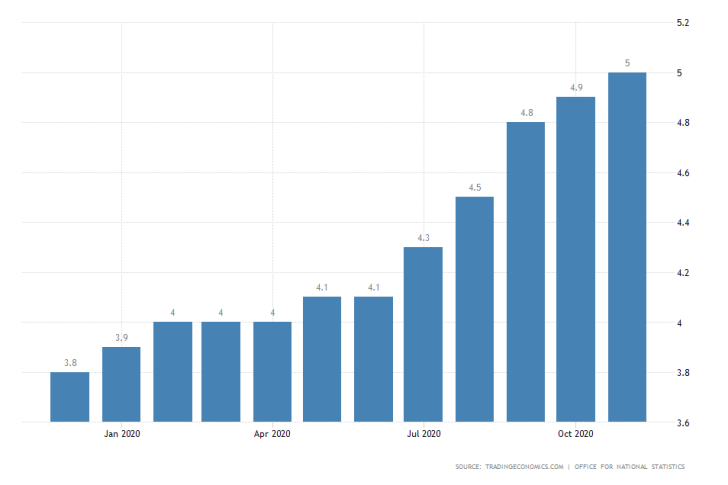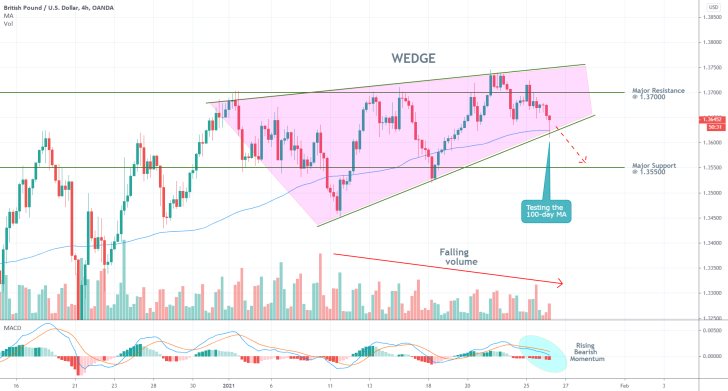
Labour market conditions in Britain worsened in the three months leading to November 2020, as Boris Johnson's government was forced to tighten the epidemic restrictions at that time owing to rising coronavirus cases.
The unemployment rate thus edged higher to 5.0 per cent from the previously recorded 4.9 per cent, say the Office for National Statistics. The final result fell below the preliminary market expectations for a surge to 5.1 per cent in headline unemployment.

Even though this was the fifth consecutive month of increasing unemployment, there are yet reasons for optimism. Namely, the number of people claiming benefits for the same period came significantly below the initial projections.
The Office for National Statistics recorded the claimant count at 7 thousand, which is considerably lower than the 38.1 thousand people who filed for support in October and the 47.5 thousand people expected to claim benefits in November.
Both of these factors cushioned the potentially adverse impact of rising unemployment on the value of the sterling, which has had a remarkable, bullish run as of late.
As can be seen on the 4H chart below, the GBPUSD continues to trade near the recent swing high, and a major bearish correction is yet to form. The underlying price action appears to be in the process of consolidating below the major resistance level at 1.37000 while developing an Ascending Wedge pattern.
Trading on the cable at present entails a high degree of risk because the underlying pieces of evidence do not seem to be pointing all in the same direction. While the fundamentals are mostly favourable for the continuation of the pound's ascend, most technical indicators are mostly demonstrative of a potential break in the trend.
Given that the price action has already failed to break out above the major resistance at 1.37000 decisively and is currently in the process of establishing the aforementioned wedge, which typically entails a likely bearish reversal, the uptrend's continuation seems at peril.
Meanwhile, the price action appears to be testing the strength of the 100-day MA (in blue) as a floating support, while the underlying market momentum is becoming increasingly more bearish, as underscored by the MACD indicator.

Trendsharks Premium
Gold is undergoing a correction, as investors take profits to offset losses from falling stock prices, impacting their margins. However, we anticipate a renewed wave of [...]
The Swiss stock market index is mirroring its global counterparts, such as Germany 40 and US100, experiencing a sharp decline following the announcement of new [...]
We’re analyzing the weekly chart to grasp the broader market trend. Over the past three years, the US30 index has surged by 17,000 points, often resembling a nearly straight [...]
Over the past week, the DAX has experienced a sharp decline, plunging by an astonishing 3,400 points. This downward movement is not isolated, as its international counterparts, such as the UK100 and US100, are also facing significant [...]
EURUSD recently formed a double top at 1.0930, signaling a potential trend reversal, and has since begun a correction. After a 600-pip rally since early March, a pullback at this stage is both expected and healthy. Given these conditions, we are placing a [...]
Since early March, EURJPY has surged nearly 1,000 pips, providing us with several excellent trading opportunities. However, as the rally matures, many early buyers are beginning to take profits, leading to a noticeable slowdown in the uptrend. On Friday, the pair formed a [...]
The AUDJPY currency pair continues to be dominated by bullish momentum, as multiple golden cross patterns reaffirm the strength of the ongoing uptrend. Despite this, we are witnessing a much-needed [...]
The EURAUD currency pair appears to be undergoing a trend reversal, signaling a potential shift in market direction. A notable technical development is the formation of a Death Cross on the chart, a widely recognized bearish indicator that typically suggests a [...]
After securing an impressive 200-pip profit last week, the EURJPY currency pair is now undergoing a southward correction, retracing some of its recent gains. Despite this temporary pullback, the Golden Cross remains intact, reinforcing our view that the overall trend continues to be [...]
The appearance of a Golden Cross in Silver strengthens our analysis that the metal is currently in a strong uptrend, indicating further bullish momentum in the market. This technical pattern, where the short-term moving average crosses above the [...]
This trade presents a considerable level of risk and can be classified as an opportunistic move based on recent price action. The GBPUSD currency pair has experienced a substantial bullish rally, surging by nearly 500 pips in a strong upward movement. However, after this extended period of appreciation, the pair is showing signs of a potential [...]
The anticipated Death Cross on the SMI20 appears to be failing as price finds strong support at the 23% Fibonacci retracement level. After testing this area, the index has shown bullish strength, printing several large green candles, signaling an increase in [...]
A Golden Cross has just appeared on the USDJPY chart, signaling a potential bullish move. This technical pattern occurs when the 20 period moving average crosses above the 60 period moving average, a widely recognized indication of increasing [...]
After 2 months of a down trend, we finally see some indications of price recovery for Oil. The golden cross, a historic buy signal, supports this [...]
For the past month, the German DAX40 has experienced a remarkable 10% surge, reflecting strong bullish momentum. Despite ongoing market volatility and frequent pullbacks, every dip continues to attract fresh buyers, reinforcing the [...]
Oil continues its downward trajectory, despite occasional pullbacks. The overall trend remains bearish, reinforced by multiple Death Cross patterns, a classic sell signal indicating further weakness. Adding to this bearish outlook, the critical [...]
Over the past few days, gold has experienced a sharp decline of more than $100. This downturn can be attributed in part to traders securing profits to manage their margins, which are under strain due to the significant drop in major indices. Currently, gold has fallen below the [...]
The NASDAQ 100 index is showing strong bullish momentum, as evidenced by the formation of a Golden Cross on the chart. This classic buy signal occurs when the short moving average crosses above the long term moving average, suggesting that upward momentum is [...]
The EURAUD currency pair has encountered a significant resistance level, failing to break above the critical 61% Fibonacci retracement level. This suggests that bullish momentum is weakening, reinforcing the case for a potential downward move. Given this technical setup, we favor entering a [...]
The UK100 is experiencing a remarkable rally! Over the past few weeks, the British stock market index has surged nearly 800 points. Each minor dip has attracted more buyers, fueling the bullish momentum. However, since last week, we’ve observed a slight [...]




















